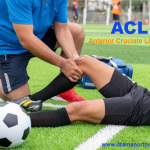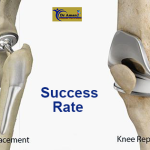ACL Tore: How Do You Know about an ACL Torn Ligament?
The human knee is a complex joint, crucial for daily mobility and countless physical activities. Unfortunately, it’s also vulnerable to injuries, with one of the most common being a torn anterior cruciate ligament (ACL). If you’re engaged in sports or physical activities, understanding the signs of an ACL tear is essential for early diagnosis and effective treatment. In this article, we’ll explore what an ACL injury is, its types, symptoms, diagnosis, prevention, and when you should seek medical attention.
Understanding ACL Tore
Your ACL, or anterior cruciate ligament, is a band of tissues that plays a crucial role in stabilizing the knee joint. Its primary function is to prevent your shinbone from sliding forward relative to your thighbone. ACL injuries are prevalent, often occurring during sports activities that involve sudden stops, changes in direction, or jumping and landing. Football and soccer players are particularly prone to these injuries.
Types of ACL Injuries
ACL injuries can be classified into two main categories: tears and sprains.
ACL Tore: This is the more severe form of injury, where the ligament is actually torn. It can be either a complete or partial tear, depending on the extent of the damage.
ACL Sprain: A sprain occurs when the ACL is overstretched but not torn.
Differentiating Between ACL Tear and ACL Sprain
ACL injuries are graded on a scale from 1 to 3:
Grade 1 Sprain: In this case, there is minimal stretching and some microscopic tearing of the ACL. The ligament remains intact, and the joint is stable, often not requiring surgery.
Grade 2 Sprain (Partial Disruption): Some tearing has occurred, and there is a separation of the ligament fibers. This results in moderate knee instability. Whether surgery is needed depends on the individual’s activity level and the degree of instability.
Grade 3 Sprain (Complete Disruption): Here, the ligament fibers are completely torn, leading to an unstable knee joint. Surgery is usually necessary in such cases.
Recognizing the Symptoms of an ACL Tore
The moment an ACL injury happens, it can be accompanied by a few telltale signs:
A Loud “Popping” Sound: Many individuals report hearing or feeling a distinct “pop” in their knee when the injury occurs.
Severe Pain: ACL injuries are often associated with intense pain in the knee area.
Rapid Swelling: The affected knee can swell up quickly, making it visibly larger than the uninjured one.
Loss of Range of Motion: Due to the injury, you might find it challenging to move your knee normally.
Knee Instability: The knee might feel like it will buckle under your weight, making it difficult to support your body.
Best diagnosing an ACL Tore
If you suspect you’ve torn your ACL, it’s essential to consult a healthcare professional for a proper diagnosis. The doctor will examine your knee, possibly manipulating it to check for signs of an ACL tore. In some cases, imaging tests like MRI or X-rays may be necessary to confirm the diagnosis and rule out other possible issues such as fractures.
Preventing an ACL Tore
While ACL injuries can be painful and disruptive, there are steps you can take to reduce your risk:
Strength Training: Regularly strengthening the muscles in your legs, core, lower abdomen, pelvis, and hips can help provide better support for your knee joint.
Sports Techniques: Learning and practicing proper sports techniques, especially those related to pivoting, cutting, jumping, and landing motions, can significantly reduce your chances of an ACL injury.
When to Seek Medical Attention
If you experience a knee injury that involves popping noises, severe pain, rapid swelling, loss of range of motion, or knee instability, it’s crucial to consult a doctor promptly. Early diagnosis and treatment can lead to better outcomes and faster recovery times.
In conclusion, knowing how to recognize the signs of an ACL tore can make a significant difference in your recovery process. Whether you’re an athlete or simply active, being aware of the symptoms, seeking timely medical attention, and taking preventative measures can help you maintain the health and stability of your knee joint.If you faced the problem of ACL tear you can contact. Best orthopedic & Sports surgeon




